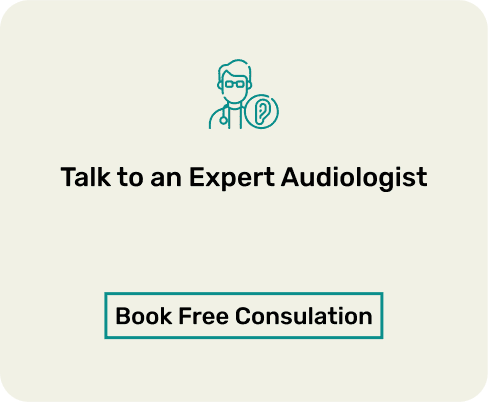Have you ever wondered if there’s a simpler way to power your hearing aids than constantly replacing tiny batteries? Rechargeable hearing aids eliminate this weekly chore entirely. But before you make the switch, understanding both the genuine advantages and honest limitations will help you make the right choice for your lifestyle.
This blog breaks down everything about rechargeable hearing aids – how they work, their real advantages and honest limitations, what they cost, lifespans of each major brand, and how Centre for Hearing® can help you find the best-suited model through expert guidance and free trials.
Understanding Rechargeable Hearing Aids
Rechargeable hearing aids are built in with silver-zinc or lithium-ion batteries that help run the device for a full day on a single charge. They recharge in a docking station, just like your smartphone. Advanced models can be continuously used for 14 to 16 hours per charge, while some brands even provide up to 51 hours. Most devices take 2 to 4 hours to charge completely.
Rechargeable hearing aids work across all popular styles. You’ll find them in Behind-The-Ear (BTE), Receiver-In-Canal (RIC), Completely in the canal and In-The-Canal (ITC) designs. The battery lifespan typically extends 4 to 5 years before requiring professional replacement. Centre for Hearing® audiologists can replace the battery unit to extend the device’s overall life.
Advantages of Rechargeable Hearing Aids

Battery Replacement Not Required
You will never have to worry about buying and disposing of batteries at the last minute. Traditional battery-powered devices require weekly replacements. Rechargeable hearing aids eliminate this recurring task completely.
This benefit matters most for people with dexterity issues and limited vision. Handling tiny batteries becomes difficult with arthritis or tremors. Simply placing your device in a charger takes seconds.
Lower Long-Term Running Costs
The cost of disposable batteries is ₹300-400 monthly. This easily adds up to ₹ 3,600 – 4,800 yearly. Over five years, you will spend ₹ 18,000 – 24,000 just on batteries. While rechargeable hearing aids may have higher upfront costs, the absence of battery expenses balances this within 2 to 3 years. Your investment pays for itself through reduced recurring costs.
Environmentally Friendly
People using traditional hearing aids dispose of around 150 batteries yearly. The harmful chemicals in these zinc-air batteries contribute to environmental pollution. Rechargeable hearing aids reduce this waste significantly as one battery replaces hundreds of disposables over its lifespan, making it an eco-conscious choice.
Easy to Charge
Many rechargeable hearing aids offer fast charging capabilities. Charging just for 30 minutes can give you around five hours of backup. Premium models, like Starkey Genesis AI, give three hours of backup from just 7 minutes of charging.
Some devices come with portable charging cases that can also be used as a storage unit. These cases provide 3 to 4 additional charges, making them useful during travel, emergencies, or power outages.
Consistent Power Throughout the Day
Rechargeable hearing aids deliver stable amplification throughout their charge cycle, unlike traditional batteries, whose power loss causes sound quality to gradually diminish before the battery dies. In addition, the rechargeable aids alert you when the charge runs low. You’ll have enough warning time before the power depletes.
Integrated with Advanced Features
Premium rechargeable hearing aids include Bluetooth connectivity and AI sound management. They stream phone calls, music, and media directly to your ears.
Want to experience these benefits firsthand? Centre for Hearing® offers a 2-day free trial of rechargeable hearing aids. Call +91 9811227269 to book your consultation today (home visits available).
Disadvantages of Rechargeable Hearing Aids

Higher Initial Purchase Cost
Rechargeable hearing aids cost ₹20,000 to ₹30,000 more than battery-operated aids. People on tight budgets may find this initial price a big challenge.
However, when long-term savings on replacement batteries is factored in, the overall ownership cost is similar or lower.
Dependent on Charging
Charging your rechargeable hearing aid every night is mandatory. Forgetting means you’ll have no hearing assistance the next day. This routine needs consistent habit formation, like owning a smartphone.
Traditional battery models don’t need nightly attention. You replace batteries only when needed. Some users prefer this flexibility over mandatory charging.
Limited Use During Power Outages
Power cuts are common in many Indian regions. During extended load-shedding, rechargeable hearing aids become unusable once the charge drains out. Traditional battery-based devices remain functional regardless of electricity availability.
However, portable devices or battery banks can solve this problem.
Battery Wear Over Time
All rechargeable batteries lose charge-holding capacity with each year. After five years, they may hold only 70% to 80% of their original charge. This means shorter daily usage before recharging becomes necessary.
They must be replaced by authorised professionals, which may cost up to ₹ 15k. This periodic expense adds to the long-term maintenance cost.
Cost of Rechargeable Hearing Aids

The hearing aid cost in India varies depending on brand, model, and features. Rechargeable hearing aids generally fall into three categories, as follows:
Standard Class Rechargeable Hearing Aids
They are priced at ₹25,000 – ₹75,000 per ear
These basic hearing aids balance performance and value smartly, have good sound quality, and are suitable for moderately active lifestyles. They also handle restaurants, meetings, and family gatherings effectively.
Top brand options include Phonak, which starts at about ₹ 115,000, Signia’s standard class, which ranges from ₹ 95,000 to ₹ 120,000, and Widex Moment 220 RIC costing about ₹ 130,000.
Advanced Class Rechargeable Hearing Aids
They are priced at ₹125,000 – ₹200,000 per ear
Advanced devices provide superior performance across various acoustic environments. They are helpful for people with demanding careers and active social lives.
Top brands worth considering are Oticon Opn S, Widex Smart, Phonak Audio Lumity, and Signia Advanced models. Their price ranges from ₹ 140,000 to ₹ 180,000.
Premium Class Rechargeable Hearing Aids
The price starts at ₹200,000 + per ear
The premium class offers high-end options with cutting-edge technical features like AI-driven sound processing, advanced tinnitus management and speech enhancement, spatial awareness for sound localisation, and remote audiologist adjustment via smartphone. They are ideal for people with complex hearing needs.
Phonak Infinio, Oticon Intent, Signia IX Series, and Starkey Genesis AI are top options from notable brands. Their price ranges from ₹ 1,80,000 to ₹ 3,50,000+.
How Long Do Rechargeable Hearing Aids from Top Brands Last?

Most devices deliver a full day’s performance on a single charge and have a total battery lifespan of 4 to 5 years. Here’s a table displaying what you can expect from each brand:
Centre for Hearing® – Expert Rechargeable Hearing Aid Solution Provider
Centre for Hearing® has been India’s trusted name in hearing healthcare since 1973. We have helped over 3,00,000 satisfied customers find their perfect hearing solution in these five decades.
We have advanced centres in Delhi, Gurgaon, Chandigarh Tricity Area, Ludhiana, Patiala, and Jalandhar. Each of our centres is run by certified audiologists who specialise in advanced hearing assessments, personalised fitting, and rehabilitation.
We can help because:
- We are a team of 50 RCI-certified audiologists who help select the most adaptable rechargeable hearing aid based on your lifestyle, budget, and hearing needs.
- We use advanced tests like Pure Tone Audiometry (PTA), Oto-Acoustic Emissions (OAE), Brain Evoked Response Audiometry (BERA), and Auditory Steady-State Response for accurate evaluation.
- Since generic amplification doesn’t work for everyone, our customised programming ensures natural sound clarity and all-day comfort.
- Our Real Ear Measurements verify that your rechargeable hearing aids deliver the right amplification for your unique ear canal acoustics.
- We provide regular adjustments during routine follow-ups, where our audiologists fine-tune your rechargeable hearing aids as your hearing profile evolves.
To schedule an appointment, call +91 9811227269. You may also email your requirements to care@centreforhearing.org.
Can Rechargeable Hearing Aids be Insured Against Loss or Theft?
Most insurance companies in India don’t provide coverage against loss, theft, or damage to hearing aids. This leaves many users without protection for this costly investment.
Centre for Hearing® addresses this gap with our exclusive 15-month Protection Plan. This unique plan covers your rechargeable hearing aids if they’re stolen, lost, or taken during a robbery anywhere in India.
The Protection Plan is available exclusively when you purchase from Centre for Hearing®.
Final Takeaway
Rechargeable hearing aids offer convenience, long-term cost savings, and consistent performance by eliminating the hassle of frequent battery replacement.
At Centre for Hearing®, our audiologists can help you choose the most suitable Phonak, Widex, Oticon, or Signia rechargeable model based on your hearing health and lifestyle.
Book a free consultation to receive a personalised hearing solution or find your nearest Centre for Hearing® location.
FAQs
1. Can children wear rechargeable hearing aids?
Rechargeable hearing aids are safe for children. At the Centre for Hearing®, paediatric models with safe designs and good battery life are available. For a hearing test, visit your nearest Centre for Hearing facility.
2. Where can I buy rechargeable hearing aids?
You must buy rechargeable hearing aids only from authorised audiology centres with qualified audiologists, such as Centre for Hearing®. Call us to locate the nearest centre. We provide end-to-end hearing assessments, professional fitting, free trials, and ongoing support.
3. Can I recharge my hearing aid with a power bank?
Most modern rechargeable hearing aid chargers connect to power banks. Power banks offer 2 to 5 additional charges. However, use a good quality power bank for maximum efficiency.
4. Can I try the rechargeable hearing aid before paying?
Yes, you can try your hearing aid for free at Centre for Hearing®. We provide a 2-day trial period. During this time, you can assess the product in different acoustic environments and make an informed decision.




















